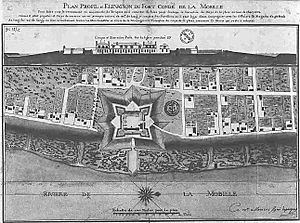Fort Charlotte, Mobile facts for kids
Quick facts for kids Fort Charlotte, Mobile |
|
|---|---|
| Native names French: Fort Condé de la Mobille Spanish: Fuerte Carlota de Mobila |
|
| Lua error in Module:Location_map at line 420: attempt to index field 'wikibase' (a nil value). | |
| Location | 150 South Royal Street, Mobile, Alabama 36602 |
| Built | 1723 |
| Built for | Louis XV of France |
| Demolished | 1820 |
| Rebuilt | 1976 |
| Governing body | Government of Mobile |
| Important events | French and Indian War War of 1812 |
| Official name: Fort Conde-Charlotte | |
| Designated | May 21, 1969 |
| Reference no. | 69000033 |
Fort Charlotte in Mobile, Alabama, is a cool historic site. It's a partially rebuilt fort from the 1700s. Over the years, it had different names like Fort Condé de la Mobille (French) and Fuerte Carlota de Mobila (Spanish). Today, it helps us remember Mobile's exciting past.
Contents
The Story of Fort Charlotte
How Mobile Began
French settlers first came to the area in 1699. They used Dauphin Island as a stop for their ships. In 1702, Jean-Baptiste Le Moyne de Bienville founded Mobile. It was first called Fort Louis de la Louisiane. This first fort was 27 miles up the Mobile River.
Moving to a New Spot
The river flooded and damaged the first fort. So, in 1711, Mobile moved to its current spot. A temporary wooden fort was built there. It was also named Fort Louis.
Building Fort Condé
In 1723, work began on a new, stronger fort. This one was made of brick with a stone base. It was renamed Fort Condé. This name honored a French prince, Louis Henri de Bourbon.
Why the Fort Was Important
Fort Condé protected Mobile for nearly 100 years. It guarded against attacks from the British or Spanish. Mobile was a very important port to the Gulf of Mexico. The fort also protected access to major rivers like the Alabama River. These rivers were like highways into the land.
What the Fort Looked Like
The original fort was huge, covering about 11 acres. It was built with local brick, stone, and earth. Even cedar wood was used in its construction. If it were fully rebuilt today, it would cover many streets in downtown Mobile.
Many Names, Many Rulers
The fort changed hands and names several times:
- From 1763 to 1780, the British controlled the area. They renamed it Fort Charlotte after Queen Charlotte. She was the wife of King George III.
- From 1780 to 1813, Spain took over. They called it Fuerte Carlota.
- In 1813, United States troops occupied Mobile. The fort was then renamed Fort Charlotte again.
The Fort's End and New Beginning
By 1820, the fort was no longer needed for defense. The U.S. Congress allowed it to be sold and taken down. Most of the fort was gone by 1823. This made way for new streets in Mobile.
However, the story didn't end there! In 1976, a special replica of the fort was opened. It was built to celebrate the United States Bicentennial. This replica is about 4/5 the size of the original. It covers almost a third of the original fort's area.
Fort Design and Features
Star-Shaped Design
The original Fort Condé, built in 1723, had a unique shape. It looked like a seven-pointed star. Guard towers stood at each point of the star. This design was common for forts of that time. It was similar to the Castillo de San Marcos fort in Florida.
Facing the River
The town of Mobile was built parallel to the Mobile River. So, the fort faced somewhat northeast. It sat on a raised area called a bluff. This bluff overlooked marshland that sloped down to the river. Even today, Royal Street in Mobile is higher up. Newer streets like Water Street are closer to the river.
French Architecture
Some buildings inside the fort had a special French style. They featured mansard roofs with dormer windows. These windows stuck out from the roof. The original fort's buildings were also longer than those in the modern replica.
The Designer
The 1725 map of Fort Condé was drawn by Adrien de Pauger. He was a very talented designer. He also designed the famous Vieux Carré in New Orleans. That area was built between 1719 and 1722.
See also
 In Spanish: Fort Condé para niños
In Spanish: Fort Condé para niños


